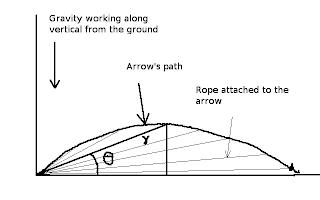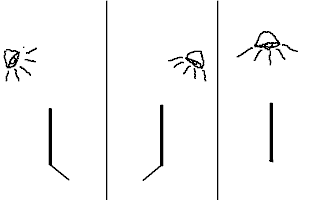The things missed in Mathematics!
1. Consider the following problem in the picture below
2. In this problem you have to connect all the six circles with only two straight lines without lifting your pen from the paper.
3. Seems simple! Try it out.
4. Here is one way to do it – magnify the circles so that they become large circles. Apply this magical transformation and you will observe that you can easily do that as shown in the below picture. In this case the problem will be solved and also you don’t have to move outside the rectangle containing the circles (if you are under the impression that you don’t have to cross boundaries of the rectangle)
5. But now, you have the question why and how this magical transformation came up? Well, the problem is actually well solved. If you can make your pen’s tip so thin that it can draw a very thin line and can draw straight lines at very minute angles, it is actually equivalent to magnifying the circles.
6. Problem is, this solution is at very subtle level and difficult to prove its applicability if the distance between the two rows of circles is varied.
7. To solve this problem in general terms you have to follow the following method by removing the restriction of moving within the rectangle containing the circles.
8. Now the problem is solved in general terms, without modifying our problem statement and explaining too many things to solve this problem.
Parlance with Casus Irreducibilis
1. The problem stated above is same as the problem of solving a cubic equation of the form
ax3 + bx2 + cx + d = 0 where a, b, c and d are real numbers and x is a variable.
2. First by applying Tschirnhaus transformation (yes, it is like magnifying the circles in our above problem), x = t – (b/3a); now keep wondering how this transformation came up out of nowhere!
3. We will get another equation in t: t3 + pt + q = 0 where p = (3ac – b2)/3a2 and q = (2b3 – 9abc + 27a2d)/27a3 . This form is also called Depressed cubic (This form doesn’t have squared part in it).
4. If we solve the above equation, then we solve our original equation.
5. The following steps will describe the Cardano’s method to solve the equation of above type in t.
6. There can be two variables u and v such that u + v = t.
7. We get an equation in u and v: u3 + v3 + (3uv+p)(u + v) + q = 0.
8. Now Cardano put one more restriction of 3uv + p = 0 – again a very magical restriction, it would seem unfathomable to know its rationale!
9. This gives us u3 + v3 = -q and u3v3 = -(p3/27). This means that v3 and u3 are the roots of the equation z2 + qz –p3/27 = 0.
10. By using quadratic formula to solve the above equation in z, we obtain
_____________ _____________
u3 = -(q/2) + √{(q2/4) + (p3/27)} and v3 = -(q/2) - √{(q2/4) + (p3/27)}
11. Cardano didn’t know complex numbers and hence assumed the term √{(q2/4) + (p3/27)} to be real and ultimately derived the roots of the generic cubic.
12. The final roots of the cubic can be real even if the square root term in the values for u3 and v3 is imaginary. That means even if you get the real roots, you can’t avoid making an intermediate calculation that will involve taking square root of negative numbers as the term (q2/4) + (p3/27) can be negative.
13. The above situation where this term can be negative is called Casus Irreducibilis (the irreducible case).
14. To avoid such a case the Complex numbers were invented. Also, invention of complex numbers explained the rationale of putting the restriction of 3uv + p = 0 by Cardano.











